Recent Progress of Non-Volatile Memory Devices Based on Two-Dimensional Materials
Abstract
1. Introduction
2. Two-Dimensional Material Overviews
2.1. Two-Dimensional Semiconductor Materials
2.2. Two-Dimensional Insulator Materials
2.3. Two-Dimensional Ferroelectric Materials
2.4. Two-Dimensional Magnetic Materials
2.5. Two-Dimensional Phase-Change Materials
3. Two-Dimensional Non-Volatile Memory Principles
3.1. Two-Dimensional Resistive Random Access Memory

3.2. Two-Dimensional Ferroelectric Memories
3.3. Two-Dimensional Magnetic Random Access Memory
3.4. Two-Dimensional Phase-Change Memories
3.5. Two-Dimensional Floating Gate Memories
4. Performance Criteria for Two-Dimensional Non-Volatile Memories
4.1. Energy Consumption
4.2. Data Processing Speed
4.3. Retention
4.4. Endurance
4.5. Variations

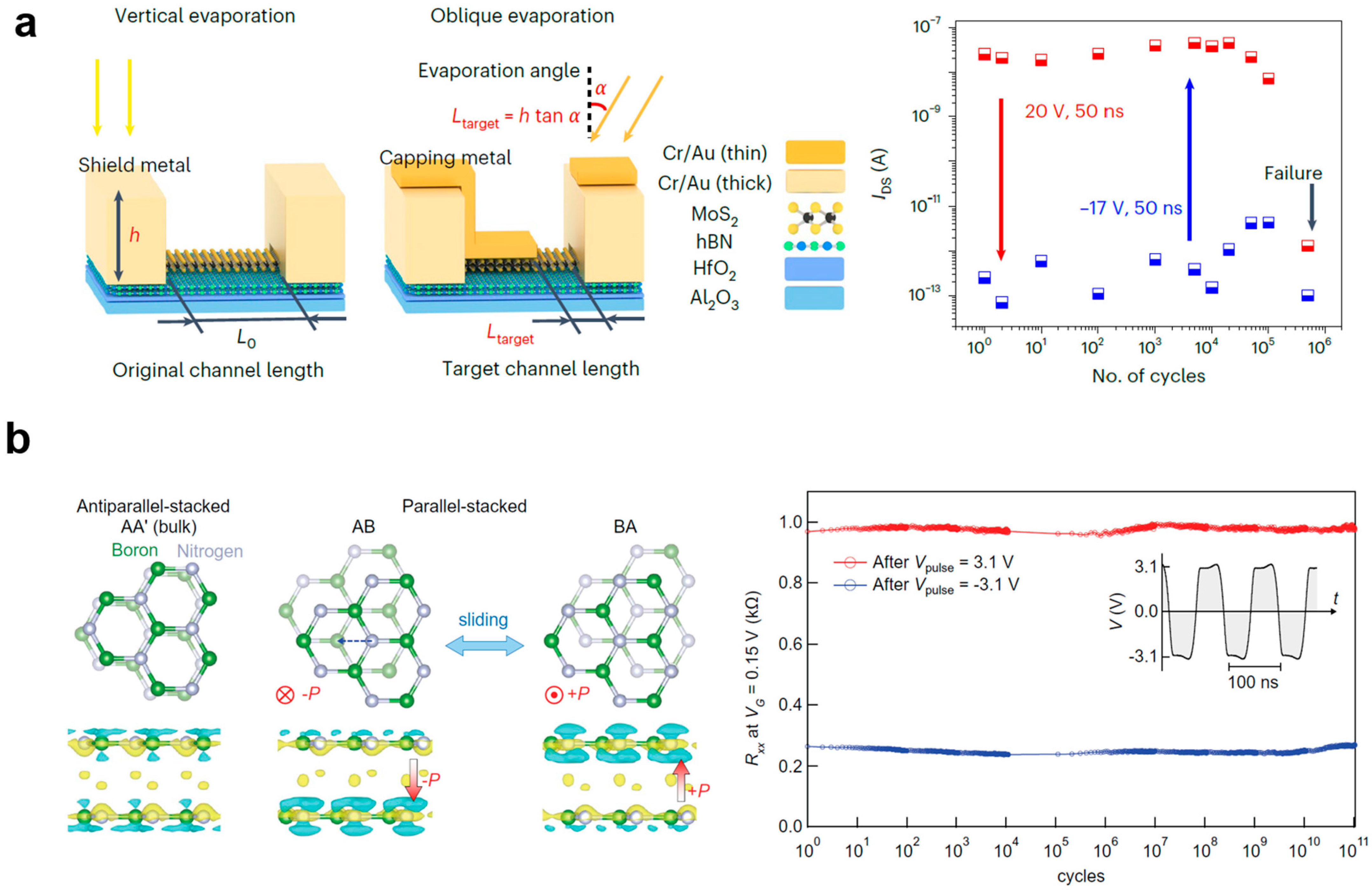

4.6. Integration
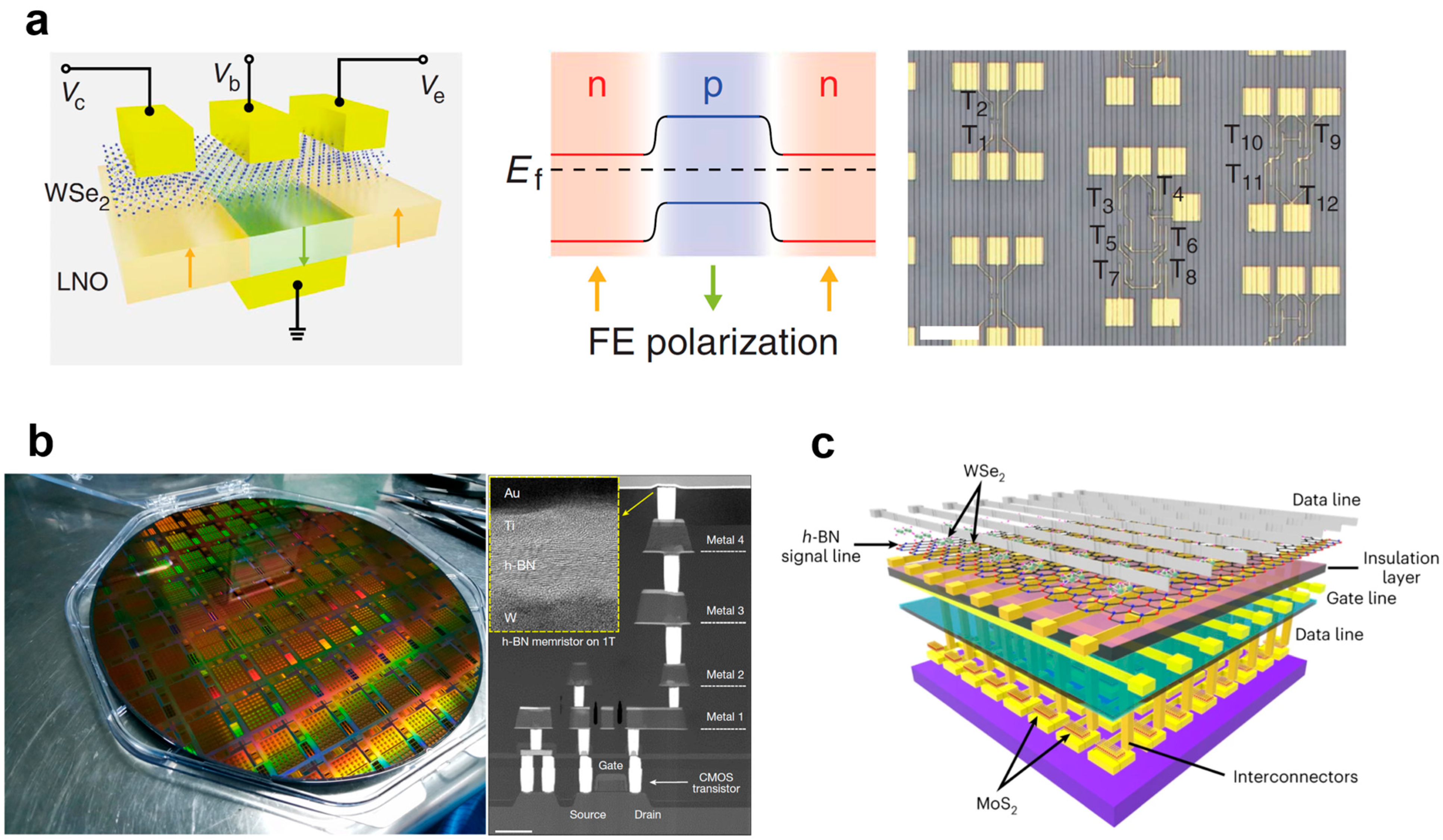
5. Two-Dimensional Non-Volatile Memory Arrays for In-Memory Computing
5.1. In-Memory Computing Architecture Mechanisms
5.2. In-Memory Computing Systems
5.3. In-Memory Sensing and Computing Systems


6. Conclusions and Outlooks
Author Contributions
Funding
Institutional Review Board Statement
Informed Consent Statement
Data Availability Statement
Conflicts of Interest
References
- Liu, A.; Zhang, X.; Liu, Z.; Li, Y.; Peng, X.; Li, X.; Qin, Y.; Hu, C.; Qiu, Y.; Jiang, H.; et al. The Roadmap of 2D Materials and Devices Toward Chips. Nanomicro Lett. 2024, 16, 119. [Google Scholar] [CrossRef] [PubMed]
- Wu, F.; Tian, H.; Shen, Y.; Hou, Z.; Ren, J.; Gou, G.; Sun, Y.; Yang, Y.; Ren, T.L. Vertical MoS2 transistors with sub-1-nm gate lengths. Nature 2022, 603, 259–264. [Google Scholar] [CrossRef] [PubMed]
- Shen, Y.; Dong, Z.; Sun, Y.; Guo, H.; Wu, F.; Li, X.; Tang, J.; Liu, J.; Wu, X.; Tian, H.; et al. The Trend of 2D Transistors toward Integrated Circuits: Scaling Down and New Mechanisms. Adv. Mater. 2022, 34, e2201916. [Google Scholar] [CrossRef] [PubMed]
- Jiang, J.; Xu, L.; Qiu, C.; Peng, L.M. Ballistic two-dimensional InSe transistors. Nature 2023, 616, 470–475. [Google Scholar] [CrossRef] [PubMed]
- Dong, L.; Jia, R.; Xin, B.; Peng, B.; Zhang, Y. Effects of oxygen vacancies on the structural and optical properties of β-Ga2O3. Sci. Rep. 2017, 7, 40160. [Google Scholar] [CrossRef]
- Wang, S.; Liu, L.; Gan, L.; Chen, H.; Hou, X.; Ding, Y.; Ma, S.; Zhang, D.W.; Zhou, P. Two-dimensional ferroelectric channel transistors integrating ultra-fast memory and neural computing. Nat. Commun. 2021, 12, 53. [Google Scholar] [CrossRef]
- Mi, M.; Xiao, H.; Yu, L.; Zhang, Y.; Wang, Y.; Cao, Q.; Wang, Y. Two-dimensional magnetic materials for spintronic devices. Mater. Today Nano 2023, 24, 100408. [Google Scholar] [CrossRef]
- Jiao, F.; Chen, B.; Ding, K.; Li, K.; Wang, L.; Zeng, X.; Rao, F. Monatomic 2D phase-change memory for precise neuromorphic computing. Appl. Mater. Today 2020, 20, 100641. [Google Scholar] [CrossRef]
- Zhou, H.; Li, S.; Ang, K.W.; Zhang, Y.W. Recent Advances in In-Memory Computing: Exploring Memristor and Memtransistor Arrays with 2D Materials. Nano-Micro Lett. 2024, 16, 121. [Google Scholar] [CrossRef]
- Zhang, Q.; Zhang, Z.; Li, C.; Xu, R.; Yang, D.; Sun, L. Van der Waals materials-based floating gate memory for neuromorphic computing. Chip 2023, 2, 100059. [Google Scholar] [CrossRef]
- Kang, J.H.; Shin, H.; Kim, K.S.; Song, M.K.; Lee, D.; Meng, Y.; Choi, C.; Suh, J.M.; Kim, B.J.; Kim, H.; et al. Monolithic 3D integration of 2D materials-based electronics towards ultimate edge computing solutions. Nat. Mater. 2023, 22, 1470–1477. [Google Scholar] [CrossRef] [PubMed]
- Radisavljevic, B.; Radenovic, A.; Brivio, J.; Giacometti, V.; Kis, A. Single-layer MoS2 transistors. Nat. Nanotechnol. 2011, 6, 147–150. [Google Scholar] [CrossRef] [PubMed]
- Liu, Y.; Tian, H.; Wu, F.; Liu, A.; Li, Y.; Sun, H.; Lanza, M.; Ren, T.L. Cellular automata imbedded memristor-based recirculated logic in-memory computing. Nat. Commun. 2023, 14, 2695. [Google Scholar] [CrossRef] [PubMed]
- Li, X.; Zhou, P.; Hu, X.; Rivers, E.; Watanabe, K.; Taniguchi, T.; Akinwande, D.; Friedman, J.S.; Incorvia, J.A.C. Cascaded Logic Gates Based on High-Performance Ambipolar Dual-Gate WSe2 Thin Film Transistors. ACS Nano 2023, 17, 12798–12808. [Google Scholar] [CrossRef]
- Chen, J.; Li, P.; Zhu, J.; Wu, X.-M.; Liu, R.; Wan, J.; Ren, T.-L. Reconfigurable MoTe2 Field-Effect Transistors and its Application in Compact CMOS Circuits. IEEE Trans. Electron Devices 2021, 68, 4748–4753. [Google Scholar] [CrossRef]
- Ahmed, Z.; Afzalian, A.; Schram, T.; Jang, D.; Verreck, D.; Smets, Q.; Schuddinck, P.; Chehab, B.; Sutar, S.; Arutchelvan, G.; et al. Introducing 2D-FETs in Device Scaling Roadmap using DTCO. In Proceedings of the 2020 IEEE International Electron Devices Meeting (IEDM), San Francisco, CA, USA, 12–18 December 2020; pp. 22.25.21–22.25.24. [Google Scholar]
- Chen, H.; Xue, X.; Liu, C.; Fang, J.; Wang, Z.; Wang, J.; Zhang, D.W.; Hu, W.; Zhou, P. Logic gates based on neuristors made from two-dimensional materials. Nat. Electron. 2021, 4, 399–404. [Google Scholar] [CrossRef]
- Pan, C.; Wang, C.-Y.; Liang, S.-J.; Wang, Y.; Cao, T.; Wang, P.; Wang, C.; Wang, S.; Cheng, B.; Gao, A.; et al. Reconfigurable logic and neuromorphic circuits based on electrically tunable two-dimensional homojunctions. Nat. Electron. 2020, 3, 383–390. [Google Scholar] [CrossRef]
- Shen, P.C.; Su, C.; Lin, Y.; Chou, A.S.; Cheng, C.C.; Park, J.H.; Chiu, M.H.; Lu, A.Y.; Tang, H.L.; Tavakoli, M.M.; et al. Ultralow contact resistance between semimetal and monolayer semiconductors. Nature 2021, 593, 211–217. [Google Scholar] [CrossRef]
- Jiang, J.; Xu, L.; Du, L.; Li, L.; Zhang, G.; Qiu, C.; Peng, L.-M. Yttrium-doping-induced metallization of molybdenum disulfide for ohmic contacts in two-dimensional transistors. Nat. Electron. 2024, 7, 545–556. [Google Scholar] [CrossRef]
- Zhang, Q.; Wang, X.-F.; Shen, S.-H.; Lu, Q.; Liu, X.; Li, H.; Zheng, J.; Yu, C.-P.; Zhong, X.; Gu, L.; et al. Simultaneous synthesis and integration of two-dimensional electronic components. Nat. Electron. 2019, 2, 164–170. [Google Scholar] [CrossRef]
- Yang, S.; Lee, G.; Kim, J. Selective p-Doping of 2D WSe2 via UV/Ozone Treatments and Its Application in Field-Effect Transistors. ACS Appl. Mater. Interfaces 2021, 13, 955–961. [Google Scholar] [CrossRef] [PubMed]
- Cao, W.; Kang, J.; Sarkar, D.; Liu, W.; Banerjee, K. 2D Semiconductor FETs—Projections and Design for Sub-10 nm VLSI. IEEE Trans. Electron Devices 2015, 62, 3459–3469. [Google Scholar] [CrossRef]
- Knobloch, T.; Illarionov, Y.Y.; Ducry, F.; Schleich, C.; Wachter, S.; Watanabe, K.; Taniguchi, T.; Mueller, T.; Waltl, M.; Lanza, M.; et al. The performance limits of hexagonal boron nitride as an insulator for scaled CMOS devices based on two-dimensional materials. Nat. Electron. 2021, 4, 98–108. [Google Scholar] [CrossRef]
- Afshari, S.; Xie, J.; Musisi-Nkambwe, M.; Radhakrishnan, S.; Sanchez Esqueda, I. Unsupervised learning in hexagonal boron nitride memristor-based spiking neural networks. Nanotechnology 2023, 34, 445703. [Google Scholar] [CrossRef] [PubMed]
- Yuan, B.; Liang, X.; Zhong, L.; Shi, Y.; Palumbo, F.; Chen, S.; Hui, F.; Jing, X.; Villena, M.A.; Jiang, L.; et al. 150 nm × 200 nm Cross-Point Hexagonal Boron Nitride-Based Memristors. Adv. Electron. Mater. 2020, 6, 1900115. [Google Scholar] [CrossRef]
- Afshari, S.; Radhakrishnan, S.; Xie, J.; Musisi-Nkambwe, M.; Meng, J.; He, W.X.; Seo, J.S.; Esqueda, I.S. Dot-product computation and logistic regression with 2D hexagonal-boron nitride (h-BN) memristor arrays. 2D Materials 2023, 10, 035031. [Google Scholar] [CrossRef]
- Zhao, Y.; Lou, Z.; Hu, J.; Li, Z.; Xu, L.; Chen, Z.; Xu, Z.; Wang, T.; Wu, M.; Ying, H.; et al. Scalable Layer-Controlled Oxidation of Bi2O2Se for Self-Rectifying Memristor Arrays with sub-pA Sneak Currents. Adv. Mater. 2024. Early View. [Google Scholar] [CrossRef]
- Io, W.F.; Pang, S.; Wong, L.W.; Zhao, Y.; Ding, R.; Mao, J.; Zhao, Y.; Guo, F.; Yuan, S.; Zhao, J.; et al. Direct observation of intrinsic room-temperature ferroelectricity in 2D layered CuCrP2S6. Nat. Commun. 2023, 14, 7304. [Google Scholar] [CrossRef]
- Liu, C.; Guan, S.; Yin, H.; Wan, W.; Wang, Y.; Zhang, Y. γ-GeSe: A two-dimensional ferroelectric material with doping-induced ferromagnetism. Appl. Phys. Lett. 2019, 115, 252904. [Google Scholar] [CrossRef]
- Zhu, L.; Lu, Y.; Wang, L. Tuning ferroelectricity by charge doping in two-dimensional SnSe. J. Appl. Phys. 2020, 127, 014101. [Google Scholar] [CrossRef]
- Hou, P.; Lv, Y.; Chen, Y.; Liu, Y.; Wang, C.; Zhou, P.; Zhong, X.; Wang, J.; Ouyang, X. In-Plane Strain-Modulated Photoresponsivity of the α-In2Se3-Based Flexible Transistor. ACS Appl. Electron. Mater. 2019, 2, 140–146. [Google Scholar] [CrossRef]
- Li, B.; Li, S.; Wang, H.; Chen, L.; Liu, L.; Feng, X.; Li, Y.; Chen, J.; Gong, X.; Ang, K.W. An Electronic Synapse Based on 2D Ferroelectric CuInP2S6. Adv. Electron. Mater. 2020, 6, 2000760. [Google Scholar] [CrossRef]
- Li, Y.; Fu, J.; Mao, X.; Chen, C.; Liu, H.; Gong, M.; Zeng, H. Enhanced bulk photovoltaic effect in two-dimensional ferroelectric CuInP2S6. Nat. Commun. 2021, 12, 5896. [Google Scholar] [CrossRef] [PubMed]
- Burch, K.S.; Mandrus, D.; Park, J.G. Magnetism in two-dimensional van der Waals materials. Nature 2018, 563, 47–52. [Google Scholar] [CrossRef]
- Huang, B.; Clark, G.; Navarro-Moratalla, E.; Klein, D.R.; Cheng, R.; Seyler, K.L.; Zhong, D.; Schmidgall, E.; McGuire, M.A.; Cobden, D.H.; et al. Layer-dependent ferromagnetism in a van der Waals crystal down to the monolayer limit. Nature 2017, 546, 270–273. [Google Scholar] [CrossRef]
- Gong, C.; Li, L.; Li, Z.; Ji, H.; Stern, A.; Xia, Y.; Cao, T.; Bao, W.; Wang, C.; Wang, Y.; et al. Discovery of intrinsic ferromagnetism in two-dimensional van der Waals crystals. Nature 2017, 546, 265–269. [Google Scholar] [CrossRef]
- Gong, C.; Zhang, X. Two-dimensional magnetic crystals and emergent heterostructure devices. Science 2019, 363, eaav4450. [Google Scholar] [CrossRef]
- Deng, Y.; Yu, Y.; Song, Y.; Zhang, J.; Wang, N.Z.; Sun, Z.; Yi, Y.; Wu, Y.Z.; Wu, S.; Zhu, J.; et al. Gate-tunable room-temperature ferromagnetism in two-dimensional Fe3GeTe2. Nature 2018, 563, 94–99. [Google Scholar] [CrossRef]
- Bonilla, M.; Kolekar, S.; Ma, Y.; Diaz, H.C.; Kalappattil, V.; Das, R.; Eggers, T.; Gutierrez, H.R.; Phan, M.H.; Batzill, M. Strong room-temperature ferromagnetism in VSe2 monolayers on van der Waals substrates. Nat. Nanotechnol. 2018, 13, 289–293. [Google Scholar] [CrossRef]
- Hu, C.; Zhu, Z.; Li, W. Two-dimensional phase-change chalcohalides. Mater. Today Nano 2023, 24, 100433. [Google Scholar] [CrossRef]
- Jacobs-Gedrim, R.B.; Murphy, M.T.; Yang, F.; Jain, N.; Shanmugam, M.; Song, E.S.; Kandel, Y.; Hesamaddin, P.; Yu, H.Y.; Anantram, M.P.; et al. Reversible phase-change behavior in two-dimensional antimony telluride (Sb2Te3) nanosheets. Appl. Phys. Lett. 2018, 112, 133101. [Google Scholar] [CrossRef]
- Duerloo, K.-A.N.; Li, Y.; Reed, E.J. Structural phase transitions in two-dimensional Mo- and W-dichalcogenide monolayers. Nat. Commun. 2014, 5, 4214. [Google Scholar] [CrossRef]
- Zhou, Y.; Reed, E.J. Structural Phase Stability Control of Monolayer MoTe2 with Adsorbed Atoms and Molecules. J. Phys. Chem. C 2015, 119, 21674–21680. [Google Scholar] [CrossRef]
- Lee, L.; Chiang, C.-H.; Shen, Y.-C.; Wu, S.-C.; Shih, Y.-C.; Yang, T.-Y.; Hsu, Y.-C.; Cyu, R.-H.; Yu, Y.-J.; Hsieh, S.-H.; et al. Rational Design on Polymorphous Phase Switching in Molybdenum Diselenide-Based Memristor Assisted by All-Solid-State Reversible Intercalation toward Neuromorphic Application. ACS Nano 2022, 17, 84–93. [Google Scholar] [CrossRef] [PubMed]
- Zhang, F.; Zhang, H.; Krylyuk, S.; Milligan, C.A.; Zhu, Y.; Zemlyanov, D.Y.; Bendersky, L.A.; Burton, B.P.; Davydov, A.V.; Appenzeller, J. Electric-field induced structural transition in vertical MoTe2- and Mo1−xWxTe2-based resistive memories. Nat. Mater. 2019, 18, 55–61. [Google Scholar] [CrossRef]
- Tang, B.; Veluri, H.; Li, Y.; Yu, Z.G.; Waqar, M.; Leong, J.F.; Sivan, M.; Zamburg, E.; Zhang, Y.W.; Wang, J.; et al. Wafer-scale solution-processed 2D material analog resistive memory array for memory-based computing. Nat. Commun. 2022, 13, 3037. [Google Scholar] [CrossRef] [PubMed]
- Sivan, M.; Li, Y.; Veluri, H.; Zhao, Y.; Tang, B.; Wang, X.; Zamburg, E.; Leong, J.F.; Niu, J.X.; Chand, U.; et al. All WSe2 1T1R resistive RAM cell for future monolithic 3D embedded memory integration. Nat. Commun. 2019, 10, 5201. [Google Scholar] [CrossRef]
- Yang, R.; Li, H.; Smithe, K.K.H.; Kim, T.R.; Okabe, K.; Pop, E.; Fan, J.A.; Wong, H.S.P. Ternary content-addressable memory with MoS2 transistors for massively parallel data search. Nat. Electron. 2019, 2, 108–114. [Google Scholar] [CrossRef]
- Shen, X.-W.; Fang, Y.-W.; Tian, B.-B.; Duan, C.-G. Two-Dimensional Ferroelectric Tunnel Junction: The Case of Monolayer In:SnSe/SnSe/Sb:SnSe Homostructure. ACS Appl. Electron. Mater. 2019, 1, 1133–1140. [Google Scholar] [CrossRef]
- Luo, Z.D.; Zhang, S.; Liu, Y.; Zhang, D.; Gan, X.; Seidel, J.; Liu, Y.; Han, G.; Alexe, M.; Hao, Y. Dual-Ferroelectric-Coupling-Engineered Two-Dimensional Transistors for Multifunctional In-Memory Computing. ACS Nano 2022, 16, 3362–3372. [Google Scholar] [CrossRef]
- Jiang, Y.; Zhang, L.; Wang, R.; Li, H.; Li, L.; Zhang, S.; Li, X.; Su, J.; Song, X.; Xia, C. Asymmetric Ferroelectric-Gated Two-Dimensional Transistor Integrating Self-Rectifying Photoelectric Memory and Artificial Synapse. ACS Nano 2022, 16, 11218–11226. [Google Scholar] [CrossRef] [PubMed]
- Khan, M.A.; Yim, S.; Rehman, S.; Ghafoor, F.; Kim, H.; Patil, H.; Khan, M.F.; Eom, J. Two-dimensional materials memory devices with floating metal gate for neuromorphic applications. Mater. Today Adv. 2023, 20, 100438. [Google Scholar] [CrossRef]
- Yang, H.; Valenzuela, S.O.; Chshiev, M.; Couet, S.; Dieny, B.; Dlubak, B.; Fert, A.; Garello, K.; Jamet, M.; Jeong, D.E.; et al. Two-dimensional materials prospects for non-volatile spintronic memories. Nature 2022, 606, 663–673. [Google Scholar] [CrossRef]
- Wang, H.; Wu, H.; Zhang, J.; Liu, Y.; Chen, D.; Pandey, C.; Yin, J.; Wei, D.; Lei, N.; Shi, S.; et al. Room temperature energy-efficient spin-orbit torque switching in two-dimensional van der Waals Fe3GeTe2 induced by topological insulators. Nat. Commun. 2023, 14, 5173. [Google Scholar] [CrossRef]
- Pan, Z.C.; Li, D.; Ye, X.G.; Chen, Z.; Chen, Z.H.; Wang, A.Q.; Tian, M.; Yao, G.; Liu, K.; Liao, Z.M. Room-temperature orbit-transfer torque enabling van der Waals magnetoresistive memories. Sci. Bull. 2023, 68, 2743–2749. [Google Scholar] [CrossRef] [PubMed]
- Shuang, Y.; Chen, Q.; Kim, M.; Wang, Y.; Saito, Y.; Hatayama, S.; Fons, P.; Ando, D.; Kubo, M.; Sutou, Y. NbTe4 Phase-Change Material: Breaking the Phase-Change Temperature Balance in 2D Van der Waals Transition-Metal Binary Chalcogenide. Adv. Mater. 2023, 35, 2303646. [Google Scholar] [CrossRef]
- Hatayama, S.; Saito, Y.; Makino, K.; Uchida, N.; Shuang, Y.; Mori, S.; Sutou, Y.; Krbal, M.; Fons, P. Phase control of sputter-grown large-area MoTe2 films by preferential sublimation of Te: Amorphous, 1T’ and 2H phases. J. Mater. Chem. C 2022, 10, 10627–10635. [Google Scholar] [CrossRef]
- Krbal, M.; Prokop, V.; Kononov, A.A.; Pereira, J.R.; Mistrik, J.; Kolobov, A.V.; Fons, P.J.; Saito, Y.; Hatayama, S.; Shuang, Y.; et al. Amorphous-to-Crystal Transition in Quasi-Two-Dimensional MoS2: Implications for 2D Electronic Devices. ACS Appl. Nano Mater. 2021, 4, 8834–8844. [Google Scholar] [CrossRef]
- Migliato Marega, G.; Zhao, Y.; Avsar, A.; Wang, Z.; Tripathi, M.; Radenovic, A.; Kis, A. Logic-in-memory based on an atomically thin semiconductor. Nature 2020, 587, 72–77. [Google Scholar] [CrossRef]
- Wu, H.; Cui, Y.; Xu, J.; Yan, Z.; Xie, Z.; Hu, Y.; Zhu, S. Multifunctional Half-Floating-Gate Field-Effect Transistor Based on MoS2–BN–Graphene van der Waals Heterostructures. Nano Lett. 2022, 22, 2328–2333. [Google Scholar] [CrossRef]
- Sasaki, T.; Ueno, K.; Taniguchi, T.; Watanabe, K.; Nishimura, T.; Nagashio, K. Material and Device Structure Designs for 2D Memory Devices Based on the Floating Gate Voltage Trajectory. ACS Nano 2021, 15, 6658–6668. [Google Scholar] [CrossRef] [PubMed]
- Li, W.; Li, J.; Chen, Y.; Chen, Z.; Li, W.; Wang, Z.; Mu, T.; Chen, Z.; Yang, R.; Meng, Z.; et al. Demonstration of Nonvolatile Storage and Synaptic Functions in All-Two-Dimensional Floating-Gate Transistors Based on MoS2 Channels. ACS Appl. Electron. Mater. 2023, 5, 4354–4362. [Google Scholar] [CrossRef]
- Li, D.; Chen, M.; Zong, Q.; Zhang, Z. Floating-Gate Manipulated Graphene-Black Phosphorus Heterojunction for Nonvolatile Ambipolar Schottky Junction Memories, Memory Inverter Circuits, and Logic Rectifiers. Nano Lett. 2017, 17, 6353–6359. [Google Scholar] [CrossRef] [PubMed]
- Zha, J.; Xia, Y.; Shi, S.; Huang, H.; Li, S.; Qian, C.; Wang, H.; Yang, P.; Zhang, Z.; Meng, Y.; et al. A 2D Heterostructure-Based Multifunctional Floating Gate Memory Device for Multimodal Reservoir Computing. Adv. Mater. 2023, 36, 2308502. [Google Scholar] [CrossRef]
- Chen, S.; Mahmoodi, M.R.; Shi, Y.; Mahata, C.; Yuan, B.; Liang, X.; Wen, C.; Hui, F.; Akinwande, D.; Strukov, D.B.; et al. Wafer-scale integration of two-dimensional materials in high-density memristive crossbar arrays for artificial neural networks. Nat. Electron. 2020, 3, 638–645. [Google Scholar] [CrossRef]
- Teja Nibhanupudi, S.S.; Roy, A.; Veksler, D.; Coupin, M.; Matthews, K.C.; Disiena, M.; Ansh; Singh, J.V.; Gearba-Dolocan, I.R.; Warner, J.; et al. Ultra-fast switching memristors based on two-dimensional materials. Nat. Commun. 2024, 15, 2334. [Google Scholar] [CrossRef]
- Ning, H.; Yu, Z.; Zhang, Q.; Wen, H.; Gao, B.; Mao, Y.; Li, Y.; Zhou, Y.; Zhou, Y.; Chen, J.; et al. An in-memory computing architecture based on a duplex two-dimensional material structure for in situ machine learning. Nat. Nanotechnol. 2023, 18, 493–500. [Google Scholar] [CrossRef]
- Yasuda, K.; Zalys-Geller, E.; Wang, X.; Bennett, D.; Cheema, S.S.; Watanabe, K.; Taniguchi, T.; Kaxiras, E.; Jarillo-Herrero, P.; Ashoori, R. Ultrafast high-endurance memory based on sliding ferroelectrics. Science 2024, 385, 53–56. [Google Scholar] [CrossRef]
- Jiang, Y.; Liu, C.; Cao, Z.; Li, C.; Liu, Z.; Wang, C.; Xiang, Y.; Zhou, P. A scalable integration process for ultrafast two-dimensional flash memory. Nat. Electron. 2024, 1–8. [Google Scholar] [CrossRef]
- Tang, J.; He, C.; Tang, J.; Yue, K.; Zhang, Q.; Liu, Y.; Wang, Q.; Wang, S.; Li, N.; Shen, C.; et al. A Reliable All-2D Materials Artificial Synapse for High Energy-Efficient Neuromorphic Computing. Adv. Funct. Mater. 2021, 31, 2011083. [Google Scholar] [CrossRef]
- Xiong, X.; Wang, X.; Hu, Q.; Li, X.; Wu, Y. Flexible synaptic floating gate devices with dual electrical modulation based on ambipolar black phosphorus. iScience 2022, 25, 103947. [Google Scholar] [CrossRef] [PubMed]
- Jahannia, B.; Ghasemi, S.A.; Farbeh, H. An Energy Efficient Multi-Retention STT-MRAM Memory Architecture for IoT Applications. IEEE Trans. Circuits Syst. II Express Briefs 2024, 71, 1431–1435. [Google Scholar] [CrossRef]
- Gargari, M.A.; Eslami, N.; Moaiyeri, M.H. A Reconfigurable Non-Volatile Memory Architecture for Prolonged Wearable Health Monitoring Devices. IEEE Trans. Consum. Electron. 2024, 70, 4717–4728. [Google Scholar] [CrossRef]
- Jian, J.; Dong, P.; Jian, Z.; Zhao, T.; Miao, C.; Chang, H.; Chen, J.; Chen, Y.F.; Chen, Y.B.; Feng, H.; et al. Ultralow-Power RRAM with a High Switching Ratio Based on the Large van der Waals Interstice Radius of TMDs. ACS Nano 2022, 16, 20445–20456. [Google Scholar] [CrossRef]
- Kang, Y.; Ma, W.; Wen, X.; Xu, Y.; Hu, H.; Zhao, Y.; Yu, B. Defect Engineering in Multilayer h-BN Based RRAM by Localized Helium Ion Irradiation. IEEE Electron Device Lett. 2024, 45, 586–589. [Google Scholar] [CrossRef]
- Wang, F.; Hamdi, M. Matching the speed gap between SRAM and DRAM. In Proceedings of the 2008 International Conference on High Performance Switching and Routing, Shanghai, China, 15–17 May 2008; pp. 104–109. [Google Scholar]
- Wu, L.; Wang, A.; Shi, J.; Yan, J.; Zhou, Z.; Bian, C.; Ma, J.; Ma, R.; Liu, H.; Chen, J.; et al. Atomically sharp interface enabled ultrahigh-speed non-volatile memory devices. Nat. Nanotechnol. 2021, 16, 882–887. [Google Scholar] [CrossRef]
- Liu, L.; Liu, C.; Jiang, L.; Li, J.; Ding, Y.; Wang, S.; Jiang, Y.G.; Sun, Y.B.; Wang, J.; Chen, S.; et al. Ultrafast non-volatile flash memory based on van der Waals heterostructures. Nat. Nanotechnol. 2021, 16, 874–881. [Google Scholar] [CrossRef]
- Li, Y.; Zhang, Z.C.; Li, J.; Chen, X.D.; Kong, Y.; Wang, F.D.; Zhang, G.X.; Lu, T.B.; Zhang, J. Low-voltage ultrafast nonvolatile memory via direct charge injection through a threshold resistive-switching layer. Nat. Commun. 2022, 13, 4591. [Google Scholar] [CrossRef]
- Wang, H.; Bao, L.; Guzman, R.; Wu, K.; Wang, A.; Liu, L.; Wu, L.; Chen, J.; Huan, Q.; Zhou, W.; et al. Ultrafast-Programmable 2D Homojunctions Based on van der Waals Heterostructures on a Silicon Substrate. Adv. Mater. 2023, 35, 2301067. [Google Scholar] [CrossRef]
- Wang, H.; Guo, H.; Guzman, R.; JiaziLa, N.; Wu, K.; Wang, A.; Liu, X.; Liu, L.; Wu, L.; Chen, J.; et al. Ultrafast Non-Volatile Floating-Gate Memory Based on All-2D Materials. Adv. Mater. 2024, 36, e2311652. [Google Scholar] [CrossRef]
- Joo, Y.; Hwang, E.; Hong, H.; Cho, S.; Yang, H. Memory and Synaptic Devices Based on Emerging 2D Ferroelectricity. Adv. Electron. Mater. 2023, 9, 2300211. [Google Scholar] [CrossRef]
- Xiang, H.; Chien, Y.C.; Li, L.; Zheng, H.; Li, S.; Duong, N.T.; Shi, Y.; Ang, K.W. Enhancing Memory Window Efficiency of Ferroelectric Transistor for Neuromorphic Computing via Two-Dimensional Materials Integration. Adv. Funct. Mater. 2023, 33, 2304657. [Google Scholar] [CrossRef]
- Sun, L.; Wang, Z.; Jiang, J.; Kim, Y.; Joo, B.; Zheng, S.; Lee, S.; Yu, W.J.; Kong, B.S.; Yang, H. In-sensor reservoir computing for language learning via two-dimensional memristors. Sci. Adv. 2021, 7, eabg1455. [Google Scholar] [CrossRef]
- Chen, J.; Zhou, Z.; Kim, B.J.; Zhou, Y.; Wang, Z.; Wan, T.; Yan, J.; Kang, J.; Ahn, J.H.; Chai, Y. Optoelectronic graded neurons for bioinspired in-sensor motion perception. Nat. Nanotechnol. 2023, 18, 882–888. [Google Scholar] [CrossRef]
- Bian, R.; He, R.; Pan, E.; Li, Z.; Cao, G.; Meng, P.; Chen, J.; Liu, Q.; Zhong, Z.; Li, W.; et al. Developing fatigue-resistant ferroelectrics using interlayer sliding switching. Science 2024, 385, 57–62. [Google Scholar] [CrossRef] [PubMed]
- Dalgaty, T.; Castellani, N.; Turck, C.; Harabi, K.-E.; Querlioz, D.; Vianello, E. In situ learning using intrinsic memristor variability via Markov chain Monte Carlo sampling. Nat. Electron. 2021, 4, 151–161. [Google Scholar] [CrossRef]
- Zheng, Y.; Ravichandran, H.; Schranghamer, T.F.; Trainor, N.; Redwing, J.M.; Das, S. Hardware implementation of Bayesian network based on two-dimensional memtransistors. Nat. Commun. 2022, 13, 5578. [Google Scholar] [CrossRef]
- Moon, J.; Ma, W.; Shin, J.H.; Cai, F.; Du, C.; Lee, S.H.; Lu, W.D. Temporal data classification and forecasting using a memristor-based reservoir computing system. Nat. Electron. 2019, 2, 480–487. [Google Scholar] [CrossRef]
- Tong, L.; Peng, Z.; Lin, R.; Li, Z.; Wang, Y.; Huang, X.; Xue, K.H.; Xu, H.; Liu, F.; Xia, H.; et al. 2D materials-based homogeneous transistor-memory architecture for neuromorphic hardware. Science 2021, 373, 1353–1358. [Google Scholar] [CrossRef]
- Wu, G.; Zhang, X.; Feng, G.; Wang, J.; Zhou, K.; Zeng, J.; Dong, D.; Zhu, F.; Yang, C.; Zhao, X.; et al. Ferroelectric-defined reconfigurable homojunctions for in-memory sensing and computing. Nat. Mater. 2023, 22, 1499–1506. [Google Scholar] [CrossRef]
- Zhu, K.; Pazos, S.; Aguirre, F.; Shen, Y.; Yuan, Y.; Zheng, W.; Alharbi, O.; Villena, M.A.; Fang, B.; Li, X.; et al. Hybrid 2D-CMOS microchips for memristive applications. Nature 2023, 618, 57–62. [Google Scholar] [CrossRef] [PubMed]
- Xie, M.; Jia, Y.; Nie, C.; Liu, Z.; Tang, A.; Fan, S.; Liang, X.; Jiang, L.; He, Z.; Yang, R. Monolithic 3D integration of 2D transistors and vertical RRAMs in 1T-4R structure for high-density memory. Nat. Commun. 2023, 14, 5952. [Google Scholar] [CrossRef] [PubMed]
- Park, S.; Lee, D.; Kang, J.; Choi, H.; Park, J.H. Laterally gated ferroelectric field effect transistor (LG-FeFET) using alpha-In2Se3 for stacked in-memory computing array. Nat. Commun. 2023, 14, 6778. [Google Scholar] [CrossRef]
- Zhang, W.; Yao, P.; Gao, B.; Liu, Q.; Wu, D.; Zhang, Q.; Li, Y.; Qin, Q.; Li, J.; Zhu, Z.; et al. Edge learning using a fully integrated neuro-inspired memristor chip. Science 2023, 381, 1205–1211. [Google Scholar] [CrossRef] [PubMed]
- Wali, A.; Das, S. Two-Dimensional Memtransistors for Non-Von Neumann Computing: Progress and Challenges. Adv. Funct. Mater. 2023, 34, 2308129. [Google Scholar] [CrossRef]
- Sebastian, A.; Le Gallo, M.; Khaddam-Aljameh, R.; Eleftheriou, E. Memory devices and applications for in-memory computing. Nat. Nanotechnol. 2020, 15, 529–544. [Google Scholar] [CrossRef]
- Haensch, W.; Raghunathan, A.; Roy, K.; Chakrabarti, B.; Phatak, C.M.; Wang, C.; Guha, S. Compute in-Memory with Non-Volatile Elements for Neural Networks: A Review from a Co-Design Perspective. Adv. Mater. 2023, 35, e2204944. [Google Scholar] [CrossRef]
- Wan, W.; Kubendran, R.; Schaefer, C.; Eryilmaz, S.B.; Zhang, W.; Wu, D.; Deiss, S.; Raina, P.; Qian, H.; Gao, B.; et al. A compute-in-memory chip based on resistive random-access memory. Nature 2022, 608, 504–512. [Google Scholar] [CrossRef]
- Yao, P.; Wu, H.; Gao, B.; Tang, J.; Zhang, Q.; Zhang, W.; Yang, J.J.; Qian, H. Fully hardware-implemented memristor convolutional neural network. Nature 2020, 577, 641–646. [Google Scholar] [CrossRef]
- Chen, C.; Zhou, Y.; Tong, L.; Pang, Y.; Xu, J. Emerging 2D Ferroelectric Devices for In-Sensor and In-Memory Computing. Adv. Mater. 2024, 2400332. [Google Scholar] [CrossRef]
- Duan, X.; Cao, Z.; Gao, K.; Yan, W.; Sun, S.; Zhou, G.; Wu, Z.; Ren, F.; Sun, B. Memristor-Based Neuromorphic Chips. Adv. Mater. 2024, 36, e2310704. [Google Scholar] [CrossRef] [PubMed]
- Taye, M.M. Theoretical Understanding of Convolutional Neural Network: Concepts, Architectures, Applications, Future Directions. Computation 2023, 11, 52. [Google Scholar] [CrossRef]
- Lin, Y.; Zhang, Q.; Gao, B.; Tang, J.; Yao, P.; Li, C.; Huang, S.; Liu, Z.; Zhou, Y.; Liu, Y.; et al. Uncertainty quantification via a memristor Bayesian deep neural network for risk-sensitive reinforcement learning. Nat. Mach. Intell. 2023, 5, 714–723. [Google Scholar] [CrossRef]
- Liu, Y.; Li, Q.; Zhu, H.; Ji, L.; Sun, Q.; Zhang, D.W.; Chen, L. Dual-gate manipulation of a HfZrOx-based MoS2 field-effect transistor towards enhanced neural network applications. Nanoscale 2022, 15, 313–320. [Google Scholar] [CrossRef] [PubMed]
- Wan, W.; Kubendran, R.; Eryilmaz, S.B.; Zhang, W.; Liao, Y.; Wu, D.; Deiss, S.; Gao, B.; Raina, P.; Joshi, S.; et al. 33.1 A 74 TMACS/W CMOS-RRAM Neurosynaptic Core with Dynamically Reconfigurable Dataflow and In-Situ Transposable Weights for Probabilistic Graphical Models. In Proceedings of the 2020 IEEE International Solid-State Circuits Conference—(ISSCC), San Francisco, CA, USA, 16–20 February 2020; pp. 498–500. [Google Scholar]
- Zhou, F.; Chai, Y. Near-sensor and in-sensor computing. Nat. Electron. 2020, 3, 664–671. [Google Scholar] [CrossRef]
- Mennel, L.; Symonowicz, J.; Wachter, S.; Polyushkin, D.K.; Molina-Mendoza, A.J.; Mueller, T. Ultrafast machine vision with 2D material neural network image sensors. Nature 2020, 579, 62–66. [Google Scholar] [CrossRef]
- Zha, J.; Shi, S.; Chaturvedi, A.; Huang, H.; Yang, P.; Yao, Y.; Li, S.; Xia, Y.; Zhang, Z.; Wang, W.; et al. Electronic/Optoelectronic Memory Device Enabled by Tellurium-based 2D van der Waals Heterostructure for in-Sensor Reservoir Computing at the Optical Communication Band. Adv. Mater. 2023, 35, e2211598. [Google Scholar] [CrossRef]
- Zhang, Z.; Wang, S.; Liu, C.; Xie, R.; Hu, W.; Zhou, P. All-in-one two-dimensional retinomorphic hardware device for motion detection and recognition. Nat. Nanotechnol. 2022, 17, 27–32. [Google Scholar] [CrossRef]
- Jiang, C.; Tan, D.; Sun, N.; Huang, J.; Ji, R.; Li, Q.; Bi, S.; Guo, Q.; Wang, X.; Song, J. 60 nm Pixel-size pressure piezo-memory system as ultrahigh-resolution neuromorphic tactile sensor for in-chip computing. Nano Energy 2021, 87, 106190. [Google Scholar] [CrossRef]
- Wang, M.; Tu, J.; Huang, Z.; Wang, T.; Liu, Z.; Zhang, F.; Li, W.; He, K.; Pan, L.; Zhang, X.; et al. Tactile Near-Sensor Analogue Computing for Ultrafast Responsive Artificial Skin. Adv. Mater. 2022, 34, e2201962. [Google Scholar] [CrossRef]
- Mo, W.A.; Ding, G.; Nie, Z.; Feng, Z.; Zhou, K.; Chen, R.S.; Xie, P.; Shang, G.; Han, S.T.; Zhou, Y. Spatiotemporal Modulation of Plasticity in Multi-Terminal Tactile Synaptic Transistor. Adv. Electron. Mater. 2022, 9, 2200733. [Google Scholar] [CrossRef]
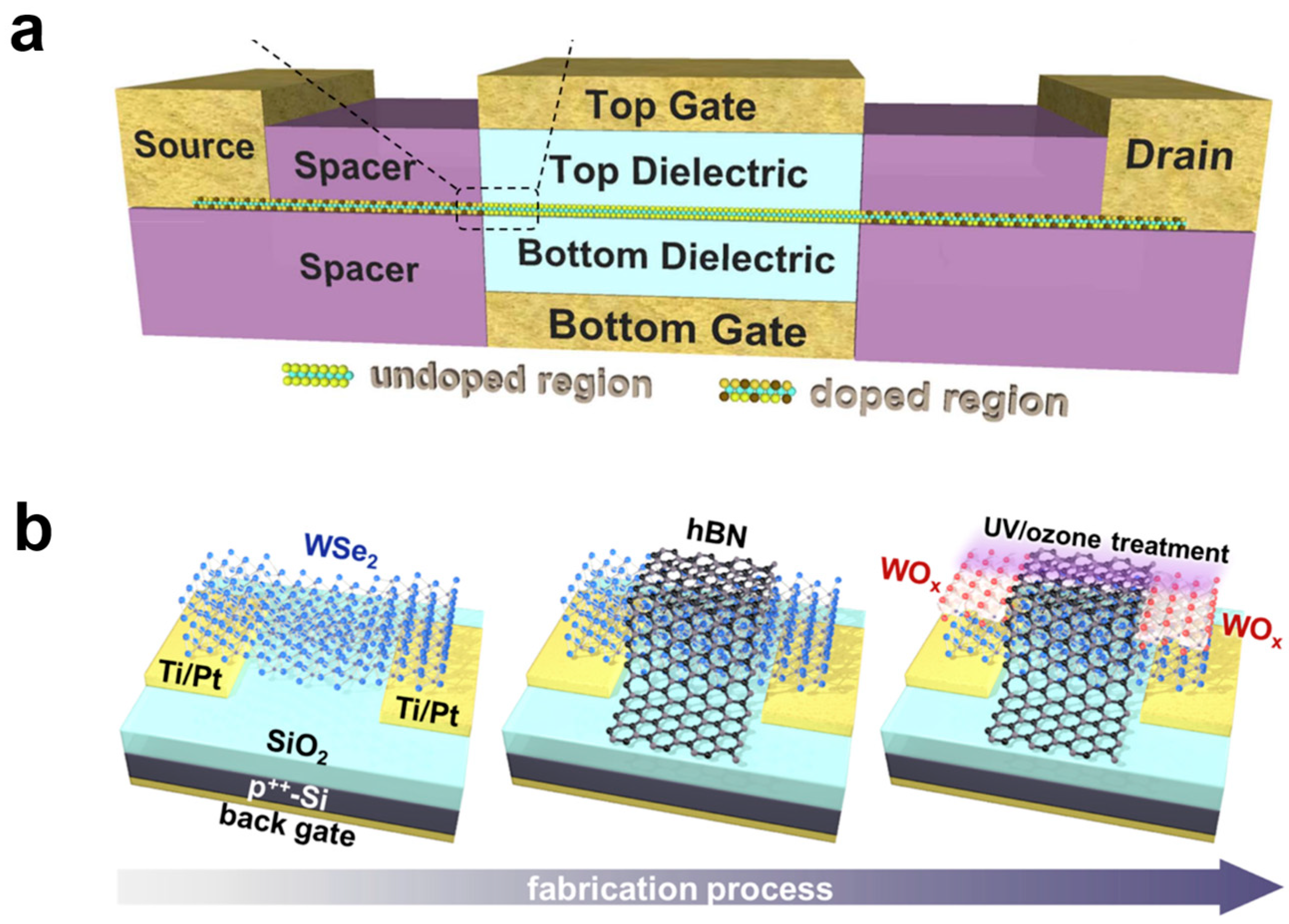
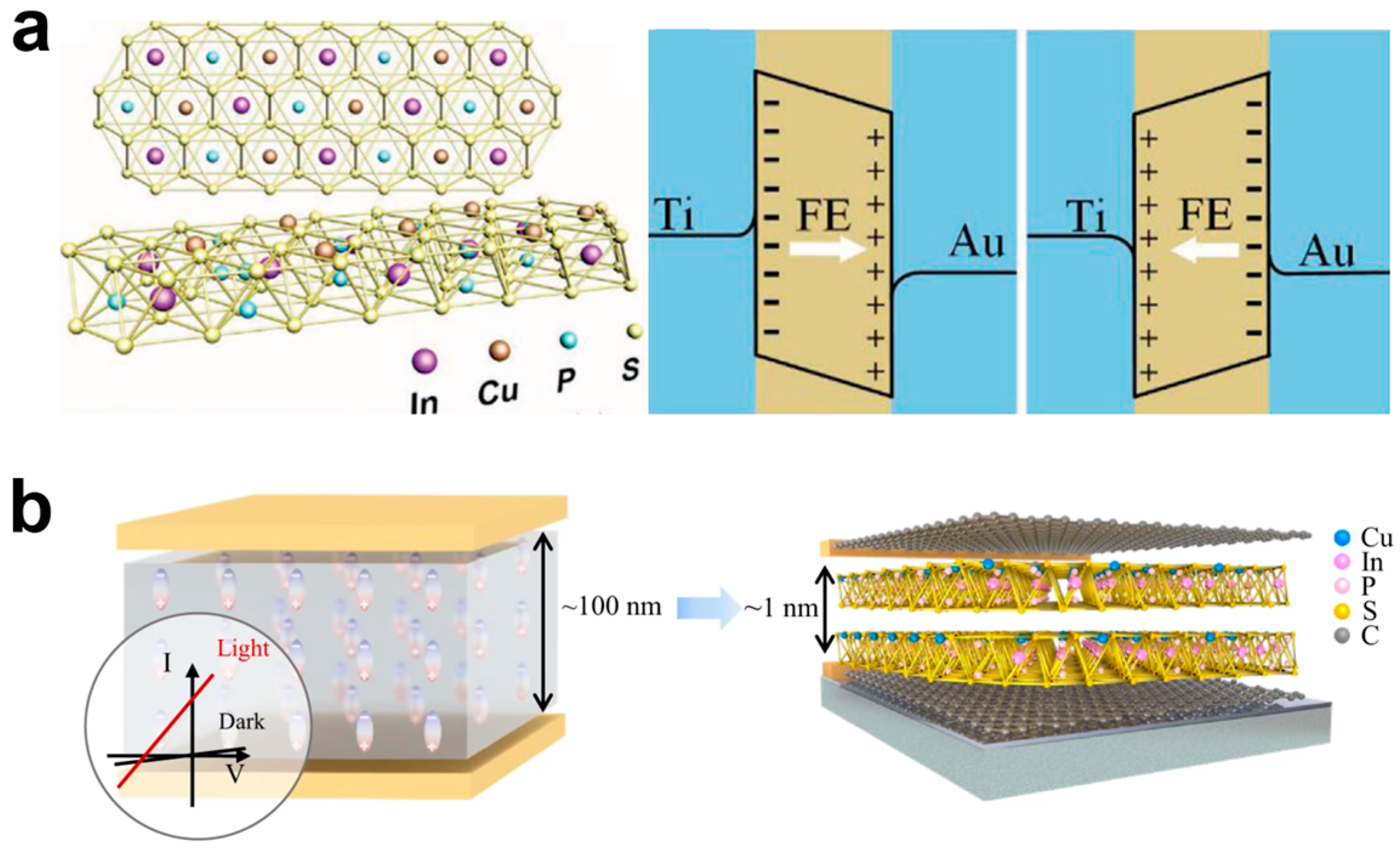
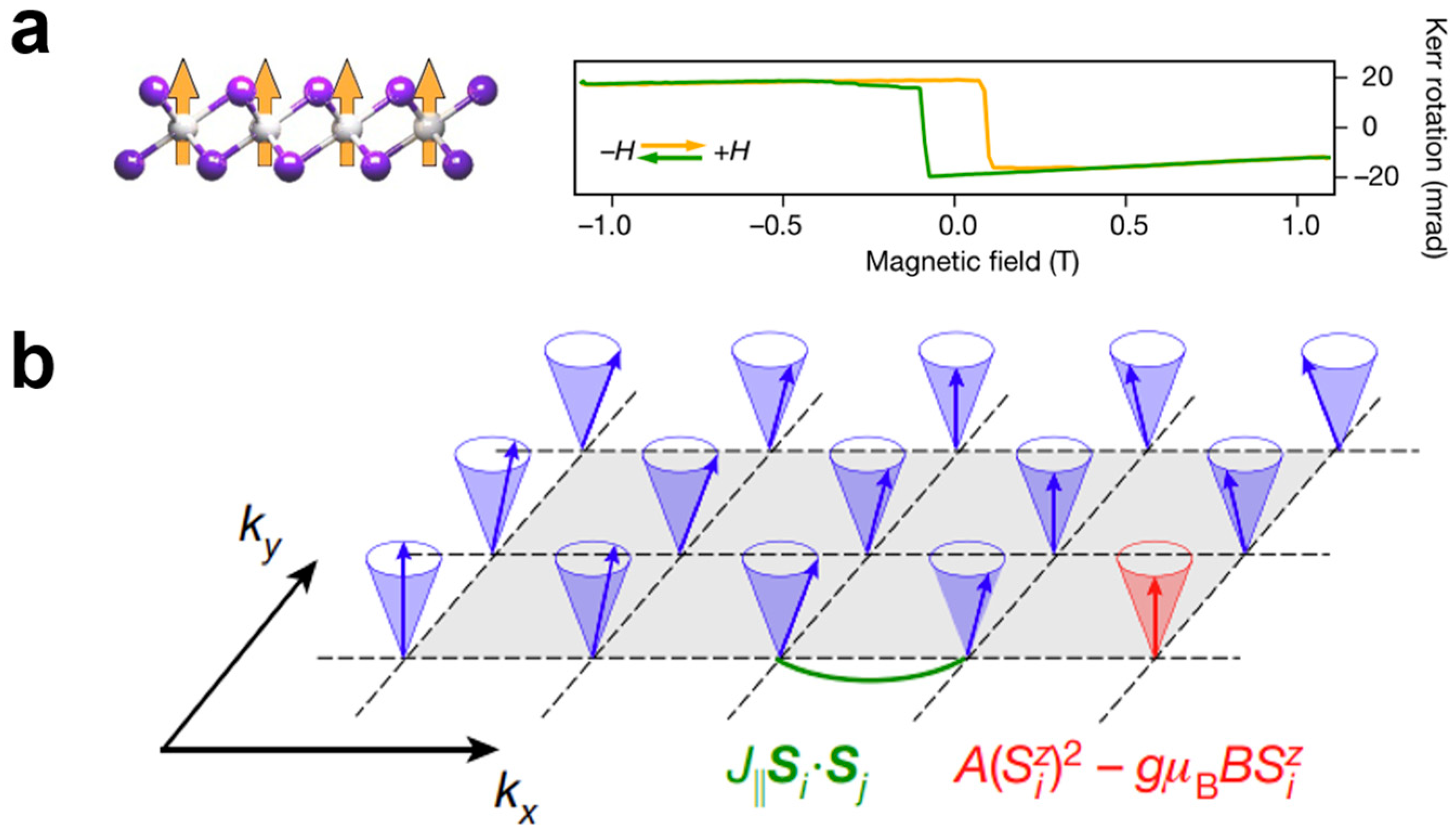




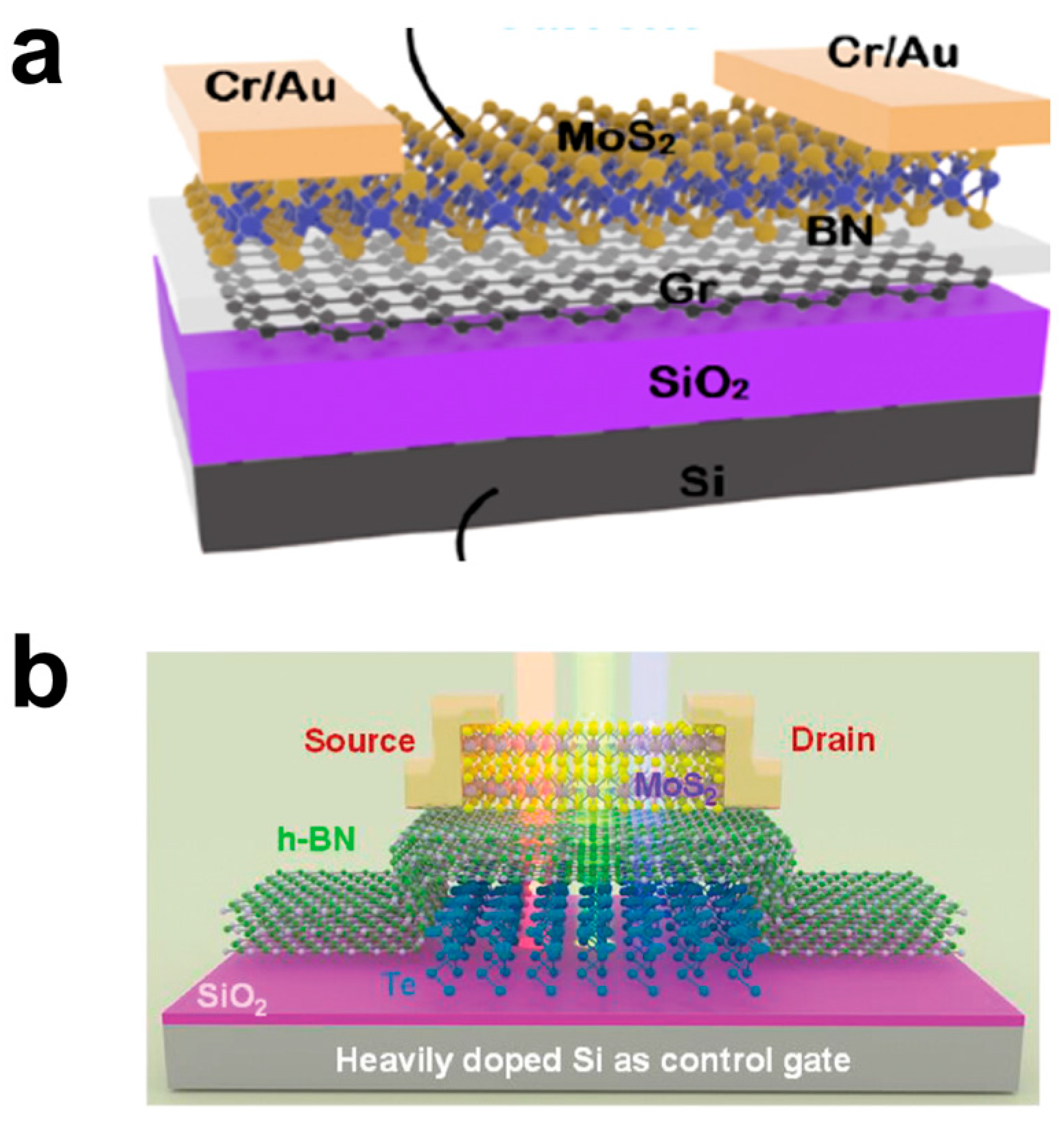
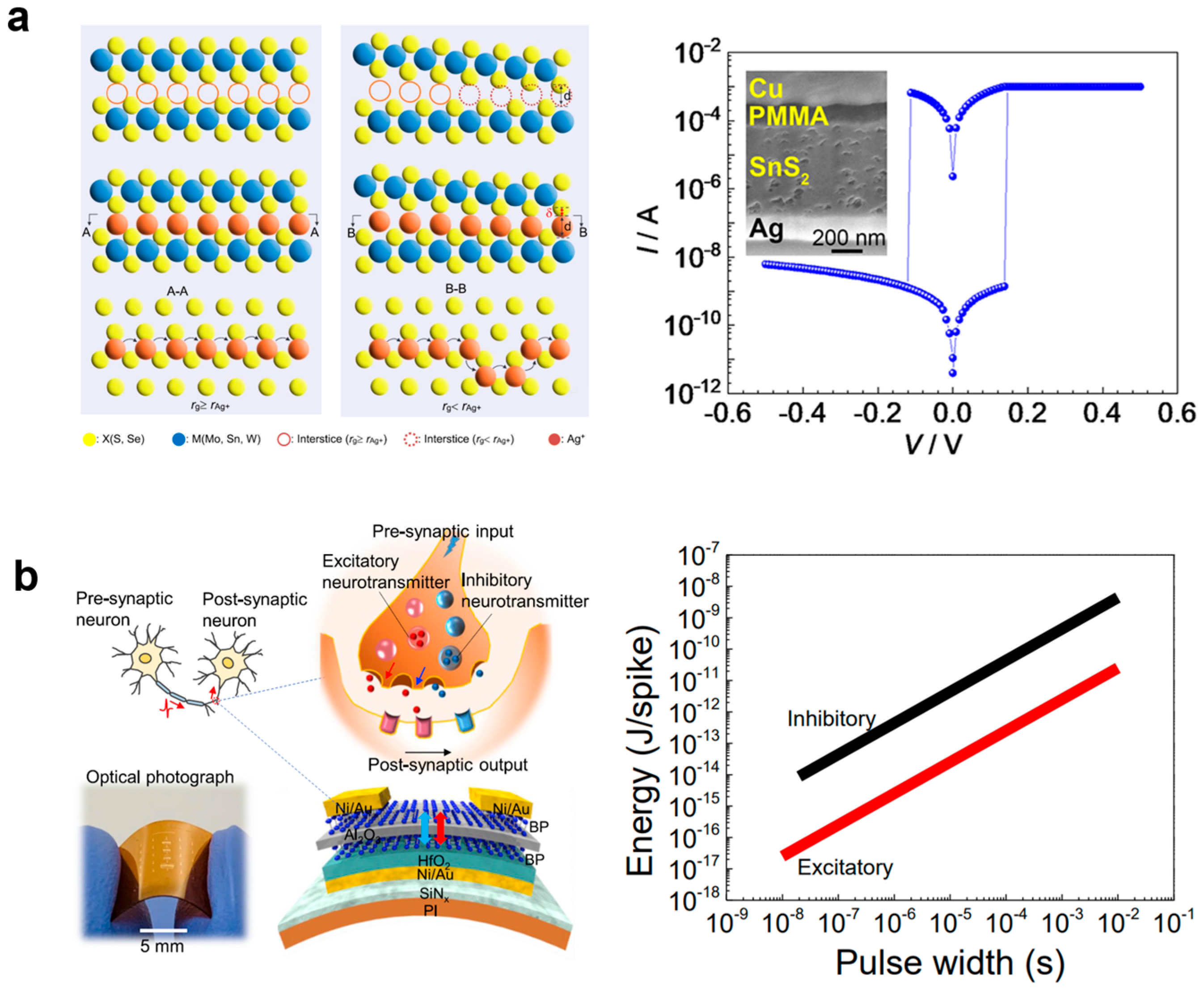


| Ref. | Material | Type | Energy | Speed | Retention | Endurance | Variations | Integration |
|---|---|---|---|---|---|---|---|---|
| [66] | h-BN | Resistive switching device | − | 200 ns | − | > 103 | Cycle-to-cycle variation of 1.53% Device-to-device variation of 5.74% | High yield of 98% High density of 150 nm × 150 nm |
| [11] | MoS2, WSe2/h-BN | Resistive switching device | − | − | ~102 s | >103 | − | Monolithic 3D integration |
| [67] | h-BN | Resistive switching device | 2 pJ | 120 ps | ~108 s | 102 | − | − |
| [6] | α-In2Se3 | Ferroelectric device | 40−234 fJ | 40 ns | ~103 s | 102 | − | − |
| [68] | MoS2/HZO | Ferroelectric device | 22.7 fJ bit−1 μm−2 | 4.8 ns | ~108 s | >1013 | Device-to-device variation of 19% | Two-layer crossbar arrays |
| [69] | Parallel-stacked bilayer BN | Ferroelectric device | − | <1 ns | ~106 s | >1011 | − | − |
| [70] | MoS2 channel with HfO2/Pt/HfO2 or Al2O3/Pt/Al2O3 | Floating gate device | − | ~20 ns | ~108 s | >105 | − | Integration of 1024 devices with yield of 98% |
| [71] | MoS2/h-BN /graphene | Floating gate device | 18 fJ | 40 ns | ~104 s | >105 | Cycle-to-cycle variation: conduction difference ΔG < 0.1 nS | − |
| [72] | BP/Al2O3/BP | Floating gate device | <1 fJ | 10 ns | − | 103 | − | − |
Disclaimer/Publisher’s Note: The statements, opinions and data contained in all publications are solely those of the individual author(s) and contributor(s) and not of MDPI and/or the editor(s). MDPI and/or the editor(s) disclaim responsibility for any injury to people or property resulting from any ideas, methods, instructions or products referred to in the content. |
© 2024 by the authors. Licensee MDPI, Basel, Switzerland. This article is an open access article distributed under the terms and conditions of the Creative Commons Attribution (CC BY) license (https://creativecommons.org/licenses/by/4.0/).
Share and Cite
Pan, J.; Wang, Z.; Zhao, B.; Yin, J.; Guo, P.; Yang, Y.; Ren, T.-L. Recent Progress of Non-Volatile Memory Devices Based on Two-Dimensional Materials. Chips 2024, 3, 271-295. https://doi.org/10.3390/chips3040014
Pan J, Wang Z, Zhao B, Yin J, Guo P, Yang Y, Ren T-L. Recent Progress of Non-Volatile Memory Devices Based on Two-Dimensional Materials. Chips. 2024; 3(4):271-295. https://doi.org/10.3390/chips3040014
Chicago/Turabian StylePan, Jiong, Zeda Wang, Bingchen Zhao, Jiaju Yin, Pengwen Guo, Yi Yang, and Tian-Ling Ren. 2024. "Recent Progress of Non-Volatile Memory Devices Based on Two-Dimensional Materials" Chips 3, no. 4: 271-295. https://doi.org/10.3390/chips3040014
APA StylePan, J., Wang, Z., Zhao, B., Yin, J., Guo, P., Yang, Y., & Ren, T.-L. (2024). Recent Progress of Non-Volatile Memory Devices Based on Two-Dimensional Materials. Chips, 3(4), 271-295. https://doi.org/10.3390/chips3040014









